Clinical psychologist shares 5 tips for human-pet separation anxiety

Have you ever felt reluctant or excessively nervous to leave your precious pet home alone as a paw-rent? Well, you’re not alone. A recent study revealed nearly half (47%) of owners experience separation anxiety whilst away from their pets, with 12% of those investing in a doggy-cam!
Of course, our beloved pets may miss us when we’re gone or may also feel separation anxiety themselves, but did you realise that you may suffer from this too?
Natural dog food brand Barking Heads has teamed up with clinical psychologist and certified dog trainer for Paws Up, Dr Holly Tett, to delve into all things pet-parent anxiety and how you can relieve the feelings….
Dr Tett shares that “you may feel twangs of anxiety when setting off on holiday without your furry friend or even as simple as heading to work. The pandemic saw a rise in anxiety for much of society across generations, which makes sense in such an uncertain time.”
“Many of us felt comforted by our pets during this time as we were home alone with them and less able to seek face-to-face comfort elsewhere, such as from colleagues or friends. So, no wonder, with life gradually returning to normal, some of us may find it harder to adjust without our pets.”
“Pet-parent anxiety is just one such example of that overall increase in societal anxiety. It’s unlikely that a certain generation (e.g. the younger or older) is more prone to pet-parent anxiety, but more that society has experienced a spike in anxiety in recent times.”
How do you know if you have separation anxiety from your pet?
Separation anxiety disorder is when a person feels anxious or afraid of being apart from a specific figure in their life. It’s common in children, but adults can also experience it. In this case, the figure is your pet.
The mental symptoms of separation anxiety may present themselves in the form of catastrophising, feeling distressed when leaving the house, or being distracted throughout the day by your thoughts of them.
However, physical symptoms such as trembling, racing heart, and feeling restless can also show this anxiety. But as with most anxiety issues, Dr Holly Tett assures there are ways to lessen and manage these feelings.
Dr Holly Tett’s FIVE steps to easing ‘pet-parent anxiety’
Keeping busywith small things in your break or the slower moments in the day may help when you start to worry about your furry friend. Rather than trying to distract yourself from your worries, try to acknowledge them when they come into your mind, think of them for a minute or two and then stand up and move around. This can help reduce the intensity of your thoughts.
Hire a pet sitter. If your pet also experiences separation anxiety, swapping places with a sitter when you go can help calm your nerves, knowing that your precious pet isn’t alone.
Check out this handy pet sitter guide which you can fill out. Easing the transition, with the comfort that your sitter knows your pet’s vital information and their favourite things.
Wean yourself off worryingwith a ‘worry window’, allowing yourself a pocket of time (10-15 minutes a day) to check in on them. Whether you have a pet sitter or a camera, check in to calm your nerves. Over time, you can work to lessen the timeframe until you’re ready to let it go.
You can also try writing down exactly what you are afraid of when you leave your pet home alone. Then imagine yourself as a lawyer. Ask what the evidence for this is. Where is the proof that this thing will happen?
We often find that there is little evidence to support our fears and so reminding yourself of this when feeling worried can help to reduce that anxiety in that moment.
Treat yourself and your petwhen you’re reunited with some well-earned cuddles and lots of quality time together.
If you are anxious about leaving your pet alone, you can do many things that might help. If your pet has separation anxiety from you, too, seek the help of a qualified pet behaviourist so that you have a plan in place to help them feel more comfortable. Doing this will likely reduce your anxiety too!
What other tactics can pet owners use to comfort themselves? Dr Holly Tett advises:
Make sure your pet has everything they need, before you leave, to know in your mind that they will be safe and comfortable whilst you are away.
If you must leave for a longer time (3+ hours) I recommend considering a professional dog walker, or a pet-sitting service that can drop in to visit your pet and offer some company.
Another great anxiety hack is to get MOVING. When we are anxious, our bodies have a physiological response too – our hearts beat faster, we might get sweaty palms, or become hyper-aware of our surroundings.
So, getting moving by doing a quick jog, jumping jacks or even rhythmically side stepping can help dispel some of that nervous energy.
If your anxiety continues to increase, try the 5,4,3,2,1, tactic: Look for 5 things you can see, 4 things you can touch, 3 things you can hear, 2 things you can smell, and 1 thing you can taste.
This simple exercise can help you feel less anxious through distraction, and you can repeat as often as you need.
What to do if the symptoms continue to worsen?
As with any kind of anxiety, if you find that you’re becoming more anxious over time or that things that used to help you feel better don’t anymore, it’s a good idea to seek help from a professional.
You could visit your GP for advice or a referral for therapy to help. It can feel scary to ask for help, but remember that what you’re feeling is very common, and it is possible to feel better.





